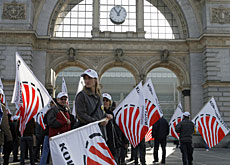Say it with a letter

It's long been said that email has been the death of the letter – but when it comes to sharing heartfelt feelings, nothing beats a handwritten letter, say the Swiss.
The volume of letters posted in Switzerland continues to slowly dwindle compared with the millions of emails sent every day, but despite this the future of the letter seems secure.
According to a recent survey by Swiss Post, three-quarters of those questioned said that letters were more personal and pleasant than emails. And most agreed that new technologies had made communication more superficial.
Last year Swiss Post delivered 2.76 billion letters compared with 2.81 billion the previous year, and since 2000, 42 per cent fewer letters have been handed in at post offices. Swiss Post expects this trend to continue, but says letters will remain a major source of income.
To find out more about whether the Swiss prefer putting pen to paper or finger to keyboard, Swiss Post contacted more than 1,000 private and business customers.
According to the results of the survey, 75 per cent of those questioned said they had an email address, while 10 per cent claimed to be disconnected from the digital revolution.
The survey revealed that a typical email user is male, under 30, employed, lives in a town or city, and receives around 18 emails per week – not including spam.
Women, on the other hand, prefer the art of letterwriting. A typical letter writer is female, over 50, lives in the countryside, mostly in French- and Italian-speaking regions, and works part-time or not at all.
A letter’s value seems to lie in its personal aspect. When it comes to sending a wedding invitation or declaration of love, for example, only one per cent and two per cent of people would use email, respectively.
There is also widespread distrust of the use of email for sending information such as bank account and salary statements.
Despite higher costs and delivery times, unlike email, a letter is rarely overlooked.
This was the experience of Zurich filmmaker Samir: “For the promotion of my last film in Germany I sent invites to people in Hamburg by email and all those in Berlin received a handwritten letter. In Berlin many more people came than in Hamburg.”
Business world
The survey revealed that in the business world, small and medium-sized businesses still prefer licking stamps and envelopes, while large companies seem to have definitely opted in favour of email.
Swiss Post also found that 81 per cent of all companies prefer to receive CVs by post and 45 per cent of all people questioned said they received far too many emails at work.
“Making comparisons with other European countries is difficult,” said Peter Hofer from the marketing research company IHA-GfK, which carried out the survey for Swiss Post.
“Switzerland has one of the highest percentages of internet users in the world and as a result the number of emails automatically explodes.”
Superficial communication
But according to communication expert Crista Dürscheid, email communication has reduced people’s writing abilities: “The fast, informal styles of writing of electronic media mean we lose the ability to hold long, structured conversations.”
But aren’t electronic media simply tools for new methods of human communication?
“Contact via email or on chat sites is more superficial, but it does allow you to get in touch with a wider group of people,” said Dürscheid.
Whilst email best compares with fast food, a letter is more like a gourmet meal, quipped Samir
“We need both, depending on the situation,” noted Dürscheid.
In the electronic age the letter seems to endure after all. But to help it on its way Swiss Post is now giving tips to customers on how and when to write letters – from a mother’s day card to an invitation to a romantic weekend away.
swissinfo, based on an article by Mariano Masserini
PostMail delivers 15 million letters a day – from greetings cards and love letters to business correspondence, direct marketing letters and newspapers.
PostFinance is a retail financial institution that has a market share of 60%, making it the undisputed leader in the Swiss payments market.
PostBus, a wholly owned subsidiary, has a network covering 12,268 kilometres and carries more than 106 million passengers a year.
There are 2,493 post offices in Switzerland – one of the densest networks in the world. There were 2,531 at the end of 2005.
The Philately unit issues about 40 new stamps a year.

In compliance with the JTI standards
More: SWI swissinfo.ch certified by the Journalism Trust Initiative



You can find an overview of ongoing debates with our journalists here. Please join us!
If you want to start a conversation about a topic raised in this article or want to report factual errors, email us at english@swissinfo.ch.